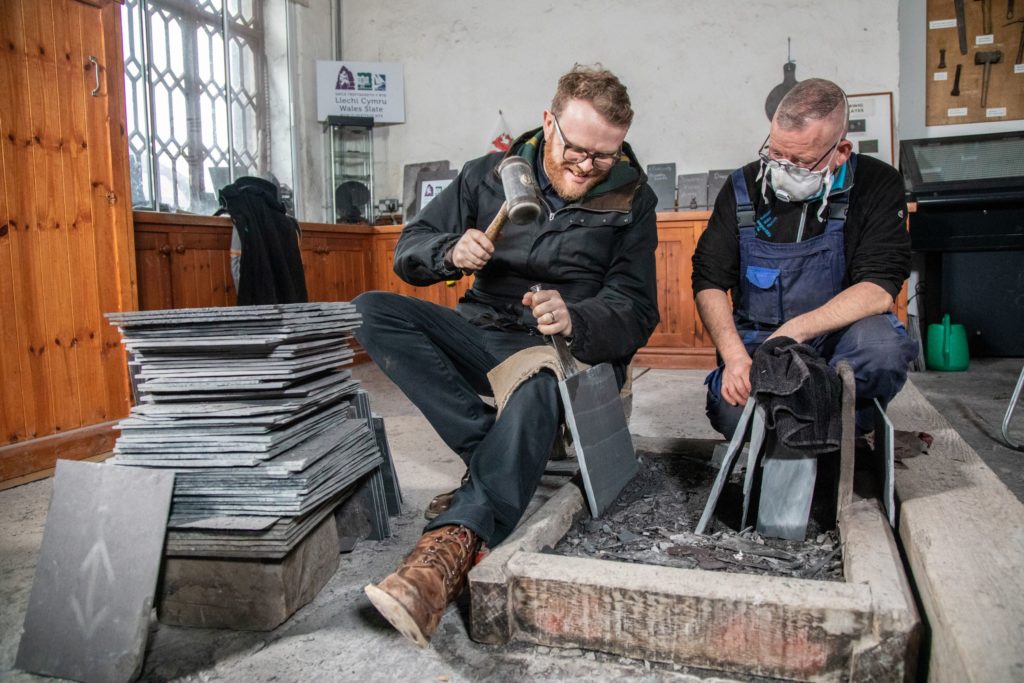
The North Wales quarrymen who roofed the world with slate share a culture with remote tribes from the Amazon to New Guinea, according to a BAFTA-winning documentary maker.
Steve Robinson, who made BBC’s acclaimed Tribe series with ex-Royal Marine Bruce Parry, is fresh from directing a film about the National Slate Museum in Llanberis for BBC 4.
The first in the new series of Inside Museums is now available on iPlayer and shows how the museum tells the story of the men who hacked out the precious black gold shipped all over the world to roof the British Empire.
The timing is particularly appropriate because the Museum is celebrating its 50th anniversary this year and the Slate Landscape of Northwest Wales was recently granted World Heritage Status by UNESCO.
Steve, from Swansea, whose credits also include the BAFTA winning Amazon with Bruce Parry, and Mekong with Sue Perkins, worked with Caernarfon-based film and TV company Cwmni Da to make the half-hour long programme.
He said: “The slate industry of North Wales isn’t as well known as the coal mines in South Wales but there’s a unique culture there centred round the Caban, the cabin where the men would eat together.
“It became a place of learning, debate, poetry and song – a place where working men came together to share their culture. There’s something very tribal about it.
“I’ve worked all over the world and lots of the tribes we visited had men’s huts where the men would gather for singing, dancing and talking – just like the Caban.”
It’s a culture familiar to Cwmni Da – three of the seven-strong team who made the programme have their roots in the slate industry including Managing Director Llion Iwan whose grandfather, John Morgan Thomas, worked at the giant Penrhyn Quarry and whose heirlooms have been used for the show which is presented by Welsh-speaking BBC Radio 6 DJ Huw Stephens, from Cardiff.
They include photographs and a list, painstakingly copied from the original by John Morgan Thomas, of all 474 men killed in accidents at the Penrhyn Quarry between 1784 and 1965.
Llion said: “Quite a few of us at Cwmni Da are from families who worked at the slate quarries so when the chance came to pitch for this it was one of those genuine passion projects for us.
“I have a huge pile of photos going back to the 1890s taken at various quarries in the area and many of these were used in the programme – when you see your grandfather aged 16 in a picture of a group of boys in the quarry it does strike you how hard life was for them.
“We were keen to make the programme to share the story about the quarrying community and what they endured but also the positive elements, their self-reliance and the social aspects of their lives.
“We also wanted to show the museum and the way it tells the story of the quarrymen and how it is housed in the Gilfach workshops which have been preserved as they were in their heyday.
“On the programme itself we had a team of seven and three of us had very close links to the slate industry.
“It is presented by Huw Stephens who didn’t know anything about quarrying before but who really got into the spirit of it and meets a sixth-generation quarryman who now works at the museum, John-Joe Jones, from Deiniolen, who teaches him how to split slates.”
The Museum lies in the shadow of the huge Dinorwig Quarry, alongside Llyn Padarn, where the Llanberis Lake Railway now carries visitors rather than the slate it once hauled down to Port Dinorwic, now Y Felinheli.
As well as the workshops the museum complex includes a row of quarrymen’s houses, transported there from Blaenau Ffestiniog and rebuilt with the décor, furniture and fittings of 1860, 1901 and 1969.
Huw Stephens was touched by the experience of working on the programme and he said: “I was aware of the slate industry and how important it was and of the incredible beauty of the landscape there but I’d never been to the National Slate Museum before.
“It is fascinating and I found it a really wonderful place. The story of slate and the people who quarried it is just mind-blowing and they tell it really well there.
“The most surprising thing was how closely-knit those communities were, their entire life revolved around the quarries and those villages were only there, halfway up a mountain, because of the quarries.
“The culture of the quarrymen was unique and extraordinary and that’s what comes across at the museum.”
Llion added: “I was 19 when my grandfather passed away. I remember he couldn’t walk far because his lungs were affected by silicosis from the slate dust.
“Back then they went to work in the quarry at 14 but he went to night school in Bethesda and I’ve found his books on history and international politics – he was a member of a book club and books and writing were really important to him.
“Among his papers there was a ledger he had copied out with the names of all the men who had died at the quarry, their ages, addresses and what had killed them – the youngest was only 16.
“My grandfather came from Mynydd Llandygai. It’s a village that grew by the quarry and is quite a barren place.”
Cwmni Da was founded in 1997 and has developed into one of Wales’s leading television and film companies whose national and international productions include factual, children’s, comedy, entertainment, drama, events and sport programmes.
The employee-owned company is an important maker of programmes for S4C, creates content for BBC and Channel 4, and has enjoyed success in the international co-production marketplace.
Cwmni Da has won the Jules Verne Adventure Award, numerous Bafta Cymru, Celtic Media and One-World Media prizes and also produces corporate, educational and promotional videos.